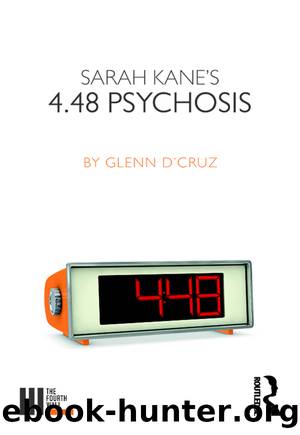Sarah Kane's 4.48 Psychosis by Glenn D'Cruz

Author:Glenn D'Cruz
Language: eng
Format: epub
Publisher: Taylor and Francis
In other words, postdramatic theatre does not seek to represent a distinct, recognisable world, nor does it attempt to tell a linear story that follows the realist conventions outlined above. Letâs break down this statement by comparing 4.48 Psychosis with Kaneâs first play, Blasted (1995), while recalling Kaneâs declaration that she found performance more interesting than literary drama.
Despite its notoriety, Blasted is, in many ways, a conventional play, at least until Kane blows up the fictional world she creates in the first part of the work. If we look at the first few pages of the published text, we can see that Kane identifies three distinct characters: Ian, Cate and Soldier. She gives Ian and Cate specific biographical attributes: âIan is 45, Welsh born but lived in Leeds much of his life and picked up the accentâ (3). She provides details of the playâs setting: âA very expensive hotel room in Leeds â the kind that is so expensive it could be anywhere in the worldâ (3). She specifies other details about this location, divides the play into clearly marked scenes, and assigns dialogue to each of the three characters. This is not to say the play is wholly naturalistic. As previously noted, the second half of the play shatters the fictional world set up in the first part of the work but continues to unfold according to a dramatic logic determined by standard notions of character and dialogue. Today, Blasted is remembered for its sexual violence and gore â the soldier rapes Ian, shoves a rifle up his arse before shooting him and sucking out one of his eyeballs. This is obviously not a scene that resonates with the work of Ibsen (or Pinter, for that matter). It is, however, most definitely âIn-Yer-Faceâ. My point is that Blasted is â on the page at least â easily recognisable as a play. The form of 4.48 Psychosis is something else. As previously stated, instead of characters, scenes and demarcated dialogue we have âbewildered fragmentsâ (2001, 210). The question I want to probe in the final section of this chapter is whether the concept of postdramatic theatre contributes anything useful to our understanding of 4.48 Psychosis.
Beyond its apparent rejection of dramatic conventions on the page, how might we understand the relationship between 4.48 Psychosis and postdramatic theatre? David Barnett suggests that Kaneâs play is postdramatic insofar as it eschews representation, temporal linearity, and flaunts its references to other works (some of which I identified in the previous chapter). On the topic of representation, Barnett argues that âthere are poetic meditations on depression that organize themselves on the page in ways that simply cannot be represented in an unambiguous fashion on stageâ (2008, 21). Indeed, it is this ambiguity that makes the play such a malleable entity â it requires the director to decide how to locate these âmeditationsâ in the theatre space without the customary stage directions. Furthermore, the play âdoes not offer a linear time structureâ (2008, 21). In other words, donât go looking for a traditional beginning, middle or end in 4.
Download
This site does not store any files on its server. We only index and link to content provided by other sites. Please contact the content providers to delete copyright contents if any and email us, we'll remove relevant links or contents immediately.
Eats, Shoots & Leaves by Lynne Truss(1128)
Nickel and Dimed by Barbara Ehrenreich(931)
Midnight's children by Salman Rushdie(787)
Bring Up the Bodies by Hilary Mantel(676)
Black Coffee (Poirot) by Agatha Christie(650)
The Lovely Bones by Sebold Alice(641)
Buried Child by Sam Shepard(625)
The 500 by Matthew Quirk(621)
The Seagull by Anton Chekhov(607)
An Ideal Husband by Oscar Wilde(587)
The Imaginary Invalid by Molière(583)
Steven Berkoff by Steven Berkoff(562)
Finding Roger by Rick Elice(507)
Tobacco Road by Erskine Caldwell(495)
Profiles by Tynan Kenneth; Tynan Kathleen;(495)
The Comedy Bible by Judy Carter(494)
Shakespeare by Paul Edmondson(481)
The Tragedy of Mister Morn by Vladimir Nabokov & Thomas Karshan & Anastasia Tolstoy(469)
Mrs. Warren's Profession by George Bernard Shaw(465)
